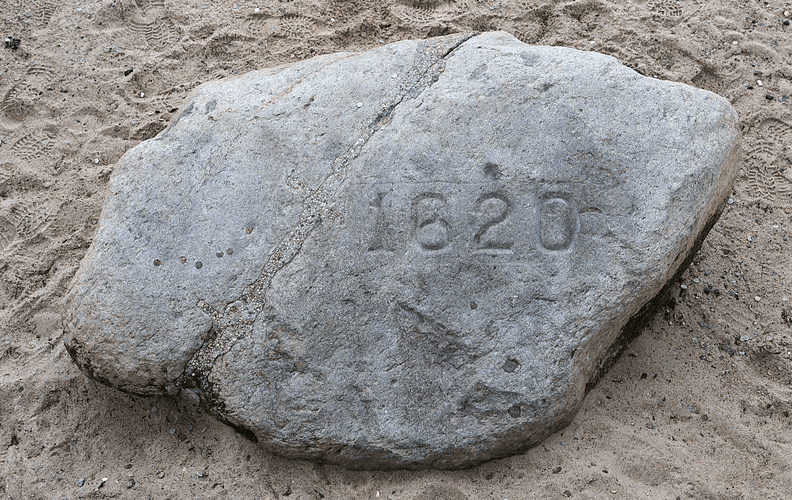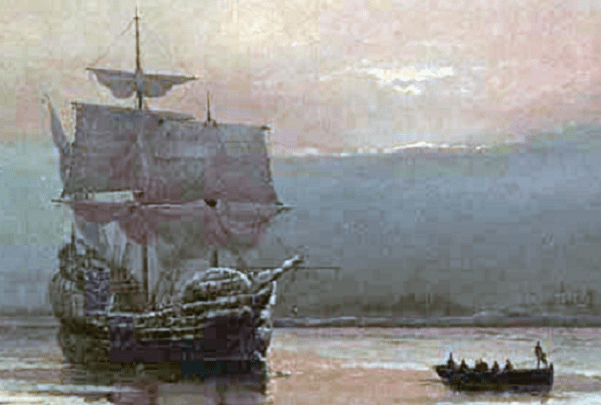Although we learn a lot about the Pilgrims and Plymouth Colony in school, it may be easy to forget some of their most interesting facts. Plymouth Colony set the stage for a future United States in terms of both culture and government. Recognizing its significance in history – and your possible connection to it – is the best way to appreciate the early efforts of these brave settlers.

The first step to learning more about Plymouth Colony is to ask the five W’s:
- Who?
- What?
- When?
- Where?
- Why?
Read on to uncover the answers and many more fascinating Plymouth Colony facts!
Who?
The answer to who founded Plymouth Colony is a bit complex. Although the most famous of the Plymouth Colony founders were the Pilgrims, their backgrounds are a bit lost to legend.
Leaders of the famed Mayflower expedition in 1620 were the same men who wrote the Mayflower Compact: William Bradford and William Brewster. The ship was owned and captained by Master Christopher Jones. However, the first person to ever exercise the governance of the Mayflower Compact was John Carver, who would later become the governor of the new colony.
In the end, the founders of Plymouth Colony were ordinary English women and men, bent on gaining a new life in America (the “New World”) where they would be free from religious persecution.
What?
Plymouth Colony, founded by Puritan Separatists from England who were later called the Pilgrims, was the second permanent and successful English colony in America, after the founding of Jamestown (1607) in Virginia.
When and Where?
So where was Plymouth Colony exactly? Two months after the three-masted cargo ship the Mayflower – not designed for people, by the way – took off from England on 16 September 1620, it anchored in present-day Provincetown Harbor, Cape Cod, Massachusetts, on November 11th.
After several weeks of exploration on foot and in a small boat they had brought with them, the Mayflower set sail west across Cape Cod Bay and anchored in Plymouth Harbor on 26 December 1620. After three days spent looking for a suitable site, the settlers stepped ashore (supposedly at Plymouth Rock) to found Plymouth Colony, the first ever permanent European settlement in New England. The Pilgrims then became the founding settlers of colonial America.
Why?
The most important question to most inquiries is: why? Why was Plymouth Colony founded?
The answer traces all the way back to the Old World.
Here are the primary reasons why the Pilgrims came to America and Plymouth Colony was founded:
- They wanted a simpler version of Christianity that was less structured than that of King Henry VIII’s Church of England, which they thought was too similar to Roman Catholicism for comfort.
- This desire for a “pure” version of Protestantism dubbed them “Puritans.”
- An even more radical group of Puritans, called the “Separatists” demanded that they separate from the Church of England to form an entirely new congregation.
- It was illegal in England at the time to be a part of anything other than the Church of England. Therefore, this was an extremely dangerous opinion to have.
- After living through harassment, fines, persecution, and jail, the Separatists fled to the Dutch Netherlands so that they could practice their religion in peace.
- After about a decade living difficult lives in the Netherlands, some of the Separatists, led by William Bradford, decided to move to the New World to find a better life.
Their intention was to continue living under English rule, all the while being able to practice Puritanism by establishing a village in the northern part of the Virginia Colony, near present-day New York City. However, as we know, the story goes a bit differently.
The rest is history.
Why Were They Called Pilgrims?
The Pilgrims were the majority of the Mayflower passengers journeying to the New World for religious freedom. How many people were on the Mayflower? There were 102 passengers and many were Separatist Puritans, emigrating from England during the reign of King James I in 1620. The name “Separatist” is pretty self-explanatory: the Pilgrims wanted to separate from the Church of England so that they could practice their own form of Christianity, called Puritanism.
They were first called Pilgrims by one of the writers of the Mayflower Compact, William Bradford. He may have been alluding to the Letter to the Hebrews 11:13-16 when he reported on his fellow settlers by writing:
“They knew they were pilgrims, and looked not much on those things, but lifted up their eyes to the heavens, their dearest country, and quieted their spirits.”
In many ways, the English Separatists were going on a necessary religious pilgrimage to gain the freedom to worship as they so desperately desired. Hence the name Pilgrim!
How Did They Survive?
The winter of 1620-1621 was a disastrous one. Over half of all the original Mayflower passengers died during its hardship and they almost lost hope. Luckily, they were saved by the generous and helpful Wampanoag and Pokanoket people, who taught them many new skills, including:
- Growing corn
- Hunting
- Fishing
- Scavenging
And thus, the first Thanksgiving was born: in the fall of 1621, the Pokanokets and the Pilgrims shared a celebratory harvest feast over three-days that would set the stage for the holiday we know today.
With this blossoming relationship, the Pilgrims and their neighboring Native American tribes secured peace treaties that helped them build a self-sufficient economy by their fifth year of settlement in New England.
Although they started off as underdogs fighting against a dominant power, the Pilgrims were able to survive and then thrive, thanks to the help of the natives of what is now the United States of America.
Learn More about Your Pilgrim Ancestry
Now that you’ve discovered so much about the famous Plymouth Colony and its founders, you may be wondering where you come in. With the resources of GenealogyBank, you can trace your Pilgrim ancestry and add to your family tree! In particular, with GenealogyBank’s Historical Newspaper Archives you can find birth and death notices, obituaries, marriage certificates, and many more records that will help you unearth the secrets behind your history and connect you with new relatives.
So, what are you waiting for?
Learn about your ancestry using our billions of records, today!
Sources:
- History.com: Plymouth Colony.
- Plimoth Plantation: Who Were the Pilgrims?
Related Article:
